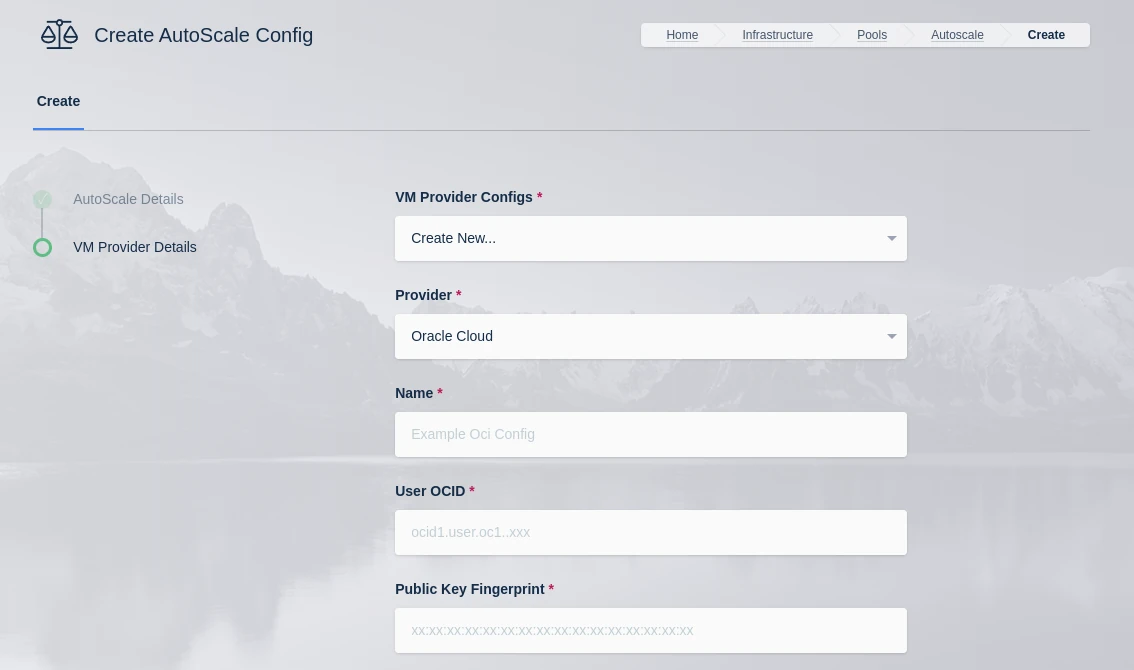
OCI VM Provider
Name |
Description |
|---|---|
Name |
A name to use to identify the config. |
User OCID |
The OCID of the user to authenticate with the OCI API. (e.g ocid1.user.oc1..xyz). You can find this by going to your OCI dashboard -> Click on your Profile -> You can find your user OCID here. |
Public Key Fingerprint |
The public key fingerprint of the authenticated API user created in OCI. (e.g xx:yy:zz:11:22:33) |
Private Key |
The private key (PEM format) of the authenticated API user created in OCI. |
Region |
The OCI Region name. (e.g us-ashburn-1). See Regions for the list |
Tenancy OCID |
The Tenancy OCID for the OCI account. (e.g ocid1.tenancy.oc1..xyz) |
Compartment OCID |
The Compartment OCID where the auto-scaled agents will be placed. (e.g ocid1.compartment.oc1..xyx) |
Network Security Group OCIDs (JSON) |
A JSON list of Security Group OCIDs that will be assigned to the auto-scaled agents.
(e.g |
Max Instances |
The maximum number of OCI compute instances to provision regardless of the need for available free slots. |
Availability Domains (JSON) |
A JSON list of availability domains where the OCI compute instances may be placed.
(e.g |
Image OCID |
The OCID of the Image to use when creating the compute instances. (e.g ocid1.image.oc1.iad.xyz) See OCI Image Families for the list |
Shape |
The name of the shape used for the created compute instances. (e.g VM.Standard.E4.Flex) See OCI Compute Shapes for the list |
Flex CPUs |
The number of OCPUs to assign the compute instance. This is only applicable when a Flex shape is used. |
Burstable Base CPU Utilization |
The baseline percentage of a CPU Core that can be use continuously on a burstable instance (Select 100% to use a non-burstable instance). Reference. |
Flex Memory GB |
The amount of memory (in GB) to assign the compute instance. This is only applicable when a Flex shape is used. |
Boot Volume GB |
The size (in GB) of the boot volume to assign the compute instance. |
Boot Volume VPUs Per GB |
The Volume Performance Units (VPUs) to assign to the boot volume. Values between 10 and 120 in mulitples of 10 are acceptable. 10 is the default and represents the Balanced profile. The higher the VPUs, the higher the volume performance and cost. Reference. |
Custom Tags (JSON) |
A Json dictionary of custom freeform tags to assigned the auto-scaled instances. e.g |
Subnet OCID |
The OCID of the Subnet where the auto-scaled instances will be placed. (e.g ocid1.subnet.oc1.iad.xyz) To create or find existing subnets, go to your OCI dashboard -> “Networking” -> “Virtual Cloud Networks” -> “Subnets” |
SSH Public Key |
The SSH public key to insert into the compute instances if you want to SSH into your instances. (e.g ssh-rsa XYABC) |
Startup Script |
When instances are provisioned, this script is executed and is responsible for installing and configuring the Kasm Agent. Example scripts can be found on our GitHub repository |
OCI Config Override |
A JSON dictionary that can be used to customize attributes of the VM request. An OCI Model can be specified with the “OCI_MODEL_NAME” key. Reference: OCI Python Docs and Kasm Examples. |